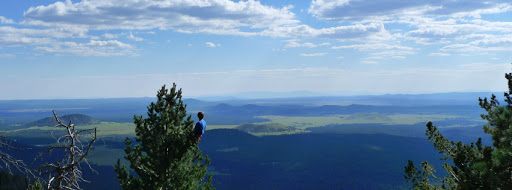You know how when you’re a kid you want to climb everything? Tables, curtains, trees, chicken coops, cars — you name it. Well, that inclination never really left me, and in August 2012 I was able to satiate those childhood urges under the guise of “work!”
Leaving the Florida summer behind, I packed all my gear into Ruby (my “new” Ford Ranger) and headed west, making it out to Flagstaff, Arizona in three days.
Sitting just under 7,000 feet, Flagstaff is an adventurer’s dream town: an hour from the Grand Canyon, literally encircled by National Forest, only a few miles south of the San Francisco Peaks (Arizona’s highest mountains), surrounded by some of the top rock climbing in the country and home to the best coffee shop the world has ever known, Macy’s. As I was to be camping for the next three months, I first gathered some maps at the Coconino National Forest office and perused the real estate offerings — I wanted to be close enough to town so commuting wouldn’t be an issue, but far enough away that the Peaks were the only structures I could see on the skyline. After scouting out a few spots I headed just north of town, finding a gorgeous campsite at the base of the mountains.
Though after getting to Flagstaff I realized I should have probably moved there long ago, what initially drew me to Arizona was the chance to work on a study concerning the invasion of an exotic tree pathogen into the American Southwest. Northern Arizona University (NAU) graduate student Betsy Goodrich and her advisor, Dr. Kristen Waring, are working with the native Southwestern White Pine (Pinus strobiformis) to proactively address threats brought about by the lethal white pine blister rust (WPBR), a fungal disease that has already caused significant stand mortality in the Pacific Northwest. Check out the video below, made at NAU and featuring Betsy and Kristen.
Betsy’s Baby Trees from Jessi Ouzts on Vimeo.
WPBR affects 5-needle pines (those which have 5 needles per fasicle, or “bundle”), including Eastern White Pine (Pinus strobus), western white pine (P. monticola) and southwestern white pine (P. strobiformis). Though its effects on high elevation ecosystems can be severe, from a purely biological perspective, it does have a fascinating life history, and the story of its spread in the U.S. is quite a tale.

But where it gets really interesting is when we look at how exactly this fungus (Cronartium ribicola) spreads. (If you’d rather not get bogged down in the details and vocabulary, skip this next bit). We start with the pine infection, which happens when one type of Cronartium spores, called basidiospores, enter pine needles through their stomata, establish a fungal infection and then grow down into the tree’s bark. Eventually the infected area swells and becomes a discolored canker. In late summer, the fungus produces fruiting structures (analogous to the toadstools we’re used to seeing on the forest floor) called spermogonia that produce another kind of spore called spermatia. These spermatia lie in a sweet drop of liquid that attracts insects, who then (unknowingly) carry the spores to other spermogonia, where they find their way onto receptive hyphae. The fusion of the spermatia and hyphae establish the dikaryon.
Next spring, other specialized reproductive structures, whitish-yellow blisters called aecia, appear where the spermogonia were the year before. Inside the aecia are masses of yet another kind of spore, aeciospores, whose abundance eventually pops the blister, releasing the aeciospores into the air. The aecia then break down, but the bark they colonized also dies. This annual spermogonia / aecia cycle is what eventually kills the tree as the fungus colonizes new bark, leaving “dead zones” in its wake.
But do these aeciospores go and infect other pines? No, that would be too simple! Instead, these spores (which can travel hundreds of kilometers) are only able to infect gooseberry (Ribes spp.), a relatively common forest shrub.

Luckily my job did not in any way require a working knowledge of this complex life cycle. I just climbed trees! Well, mostly — there was some community classification and environmental data to collect, but for the most part, we climbed. Our job took us all over eastern Arizona and western New Mexico to chase the elusive cone of the Southwestern White Pine. From the cones, Betsy could get seed, some of which went to seed banks, but most of which was to be used (as explained in the video above) to explore the spatial distribution and genetic basis of resistance to WPBR (as some pine individuals are more resistant to the disease than others). This knowledge could be invaluable in planning for effective forest management under the threat of a WPBR invasion in the Southwest.

Our climbing team consisted of Chris, Shaughn and me, and after a couple days of training with Terry (US Forest Service), we were certified tree climbers! Don’t get me wrong, I love vegetation surveys, but there’s no field job like scaling a 90 foot pine and then getting to rappel down.


After climbing season ended in early October, I stayed on for a couple weeks to help harvest seeds from the cones. I told myself I would stay in Flag until my water bottle froze in my tent — I made it through a few light snow showers before that happened, but the day before Halloween I packed up my truck, said goodbye to Betsy and crew, and headed back east. But not before paying a visit to our national treasure, the Grand Canyon, which we’ll explore in the next post!












Awesome, again, John William! Uncle Stephen
LikeLike